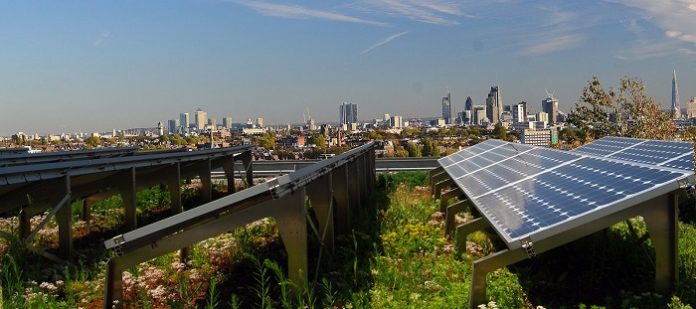New government policy combined with the new regulation is driving renewable energy generation, and the solar market is expected to have strong growth in the future. Due to the current increase of power density in solar inverters and the demand for energy storage balancing, this generation of solar power leads to a need to significantly monitor all elements of a solar system. For solar PV applications, RS-485 communications are used due to inherent noise immunity. Adding iCoupler isolated RS-485 transceivers provides a safe, reliable, and EMC robust solution for solar PV network communication interfaces.
RS-485 has several uses, the primary use being remote monitoring of power generation, PowerPoint trackers, and energy storage status (battery storage).
For solar applications like energy storage communications is critical, as it alerts the user of power generation and consumption activities within their solar installation. Several systems strategies may be installed such as bill management, PV self-consumption, demand charge reduction, and backup power. Backup power is the most popular, especially in the U.S., due to the various hurricanes causing havoc in the states of Texas and Florida.
| Domestic Energy Storage Strategy | Definition |
| Bill Management Time of Use (TOU) | Minimizes electricity purchases during peak electricity consumption hours, while TOU shifts purchases to lower rates behind the meter customers. The goal of this strategy is to reduce the customer’s bill. |
| PV Self-Consumption | Minimize the export of electricity generated by behind-the-meter PV systems to maximize the financial benefits in PV areas where utility rates are high. |
| Demand Charge Reduction | Reduce costs when utility companies charge excessively during peak times so customers can store energy. |
| Backup Power | This is a more common strategy and is the charging of any storage capable devices to use when the grid is down or at night time. This is more a backup power strategy, where low utility charges are available at peak times and there are low feed-in tariffs. |
Solar generation, energy storage, and domestic consumption in a typical, 24-hour day is illustrated in Figure 1. Figure 1 is the primary reason why systems are designed for bill management in a solar system. During nighttime when there is no irradiation on the solar panel, energy consumed will be purchased from the grid where the grids are lowest. As soon as the sun rises irradiation appears on the solar panels, power is generated, and domestic self-consumption begins where any solar generation is either used in the household or is diverted to charge the energy storage unit. This allows bill costs to be controlled by reducing the energy drawn from the grid and using solar-generated energy where low feed-in tariffs are available from utility companies.
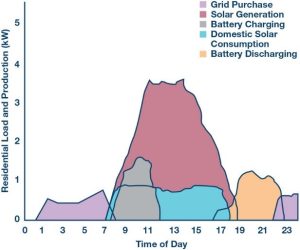
RS-485 is the communication application of choice for PC screen data updates such as current power, current consumption in the maximum power point trackers, battery charge and health, and CO2 reduction, etc., are available, as can be seen in Figure 2.
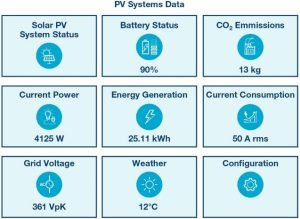
Figure 3 illustrates a typical solar system with input-for-input dc strings, dc-to-ac conversion, energy charging and storage, and battery management and communications. Analog Devices offers a complete power, communication, and control interface signal chain solution for solar PV and energy storage applications. iCoupler isolated gate driver solutions include the ADuM4135 and ADuM4223/ADuM3223; iCoupler isolated communication port solutions include the ADM2795E, ADM2867E, and ADM3054; and mixed-signal processor solutions include the ADSP-CM40x.
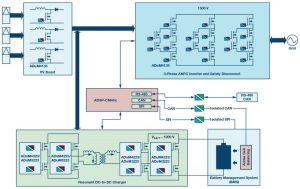
Why Use RS-485 Transceivers with iCoupler Isolation?
iCoupler isolation provides a safe, reliable, and an EMC robust solution for solar PV network communication interfaces.
For solar PV networks the RS-485 or CAN communications interfaces often run over long cables in an electrically noisy environment. RS-485 communications are differential in nature and inherently noise immune. Adding iCoupler isolation increases noise immunity.
- The iCoupler family of digital isolation products has been tested and approved by various regulatory agencies, including UL, CSA, VDE, TÜV, CQC, ATEX, and IECEx. This regulatory agency testing provides a certified level of safety in the presence of high voltage transients and electrical surges that can occur in electrically harsh solar PV environments.
- The solar PV communications interface usually operates at low data rates—less than 500 kbps—which is an ideal operating range for RS-485 communications. Alternative implementations such as Ethernet operate at fixed data rates of 10 Mbps/100 Mbps or 1 Gbps, which are clearly overdesigned for the application requirement.
- iCoupler isolation has proven EMC robustness, which reduces field failures. Added EMC robustness reduces design and test time for interface circuits, allowing faster time to market for solar PV networks.
Drop-In iCoupler Isolation Solution for Existing Solar PV Networks
For existing installations of solar inverters, which do not include iCoupler isolation robustness on the communications port, the iCoupler isolated RS-485 repeater is a powerful drop-in solution. The compact, signal, and power iCoupler isolated RS-485 repeater delivers robust isolation protection against electrical noise in electromagnetic capability (EMC) harsh solar environments.
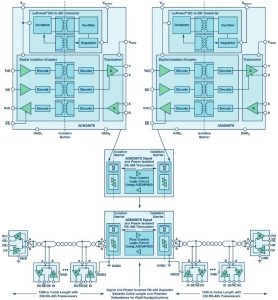
The iCoupler isolated RS-485 repeater design consists of two RS-485 transceivers and two high-speed ADCMP600 comparators. The ADM2867E is a fully integrated signal and power isolated data transceiver with ±15 kV ESD protection, and is suitable for high-speed communication on multipoint transmission lines. The ADM2867E includes an integrated, isolated dc-to-dc power supply, which eliminates the need for an external dc-to-dc isolation block. An RS-485 repeater requires flow control, which is essential for controlling the direction of communication on the RS-485 bus. Using the ADCMP600 high-speed comparator allows high-speed flow control and directionality on the ADM2867E logic pins, which results in a reliable communication system. For complete design guidelines please refer to AN-1458 Application Note Isolated RS-485 Repeater with Automatic Direction Control.
iCoupler Signal Isolated RS-485 with Additional EMC Robustness
When designing an EMC communications interface, the circuit designer is often faced with a design and test iterative cycle. The circuit needs to be designed to meet system-level EMC standards and customer requirements. System-level IEC standards, such as IEC 61131-2 for industrial automation, specify varying levels of protection against IEC ESD, EFT, and surge, as well as immunity to radiated, conducted, and magnetic disturbances.
Analog Devices iCoupler signal isolated RS-485 includes additional certified EMC protection against these noted disturbances, reducing time to market for designs that need to meet strict regulatory targets.
In particular, the ADM2795E RS-485 transceiver integrates isolation robustness and EMC protection, which saves significant printed circuit board (PCB) board space for the solar PV communication port interface.
The ADM2795E is a 5 kV rms signal isolated RS-485 transceiver that features up to ±42 V of ac-to-dc, peak bus overvoltage fault protection on the RS-485 bus pins. The device integrates Analog Devices iCoupler technology to combine a 3-channel isolator, RS-485 transceiver, and IEC electromagnetic compatibility (EMC) transient protection in a single package.
The ADM2795E integrated iCoupler technology is certified by VDE0884-10, UL 1577, CSA, and CQC (pending).
- Working voltage: 849 VPEAK (600 V rms) reinforced approved by VDE 0884-10
- Withstand voltage: 5000 V rms approved by UL1577
The ADM2795E performs robustly in several system-level EMC tests, which are certified by an EMC compliance test house (certification is available on request):
- IEC 61000-4-5 surge
- IEC 61000-4-4 EFT
- IEC 61000-4-2 ESD
- IEC 61000-4-6 conducted RF immunity
- IEC 61000-4-3 radiated RF immunity
- IEC 61000-4-8 magnetic immunity
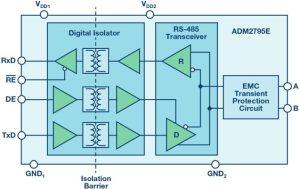
Conclusion
Analog Devices offers a complete signal chain solution for solar PV and energy storage applications. iCoupler isolated gate driver solutions include the ADuM4135 and the ADuM4223/ADuM3223, while iCoupler isolated communication port solutions include the ADM2795E and ADM2867E, with the ADSP-CM40x mixed-signal control processor offering a power communication and control interface. iCoupler isolation provides a safe, reliable, and EMC robust solution for solar PV network communication interfaces.
Analog Devices’ interface and isolation portfolio has several options for isolating your RS-485 interface. The ADM2795E provides a complete, system-level EMC solution with compliance to IEC 61000 surge, EFT, and ESD standards, as well as immunity to conducted, radiated, and magnetic disturbances, which are common in harsh solar PV environments. The ADM2795E reduces time to market for designs that need to meet strict regulatory targets.
Signal and power isolated RS-485 transceivers, such as the ADM2867E, provide the most integrated signal and power isolated solution available on the market today. The ADM2867E can be used in an RS-485 repeater design to provide a path to adding iCoupler isolation robustness in designs that are already completed.
Contributory Authors





